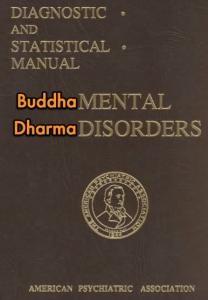
I’ve just learned that the new Diagnostic and Statistical Manual of Buddhamental Dharmadisorders – 000 is now available and that there have been significant additions. Most notable is in the “Elimination Disorders” section, under “Mansplaining,” of the subtype, “Dharmasplaining.” In this post, I share that section with you:
Dharmasplaining Defined
The excessive need to verbally offgas about the buddhadharma, manifested either in person or online, by making lengthy assertions that far exceed one’s personal experience, such that one’s self-aggrandizing communication squeezes out other, more experienced and knowledgeable participants, often, but not always women and younger people. Those who identify as white males over age 50 are most prone to this affliction (causes as of yet not fully determined). Because one stricken with Dharmasplaining is prone to engage in pissing contests, and because the disorder was previously and more commonly known as “talking out of your ass,” therefore, it is included in the Elimination Disorder section.
Diagnostic Criterion
If any three are present on a more than monthly basis:
- Comments on a social media exceeding 100 words on a link to a blog post without reading the blog post.
- Comments on a social media exceeding 100 words on a link to a blog post with reading the blog post.
- During the dharma dialogue portion of a dharma talk, raises a question to the teacher by talking for over three minutes and then noting, “Well, I guess there really wasn’t a question there.”
- Either in person or online, uses the phrase, “Yeah, wasn’t it Suzuki [insert other dead guys as fitting] Roshi who said….”
- Writes a blog post about the true meaning of Dogen’s [insert other dead guys as fitting] teaching.
- Words-about-dharma to minutes-of-zazen ratio exceeds 3:1.
- Doesn’t find this funny.
- Doesn’t think this applies to him/her.
Treatment
Results are most positive if more than one of the following treatment types are employed:
- Ten years, sixty-minutes a day zazen with no sweet cookies.
- Ten years, minimum 40-days sesshin with no sweet cookies.
- One good koan worked thoroughly with no sweet cookies.
- Weekly dokusan with a qualified teacher with no sweet cookies.
- Undertaking a training position (timekeeper, liturgist, cook, etc.) at a local center with no sweet cookies.
- 90-day residential practice period with no sweet cookies.
Notes
- Optimal doses of the above may vary.
- More than one round of treatment may be required.
- Continued use of social media during treatment is contraindicated.












